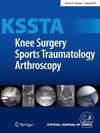Lateral meniscus posterior root repairs show superior healing, reduced meniscal extrusion and improved clinical outcomes compared to medial meniscus posterior root repairs: A systematic review
Abstract
Purpose
To systematically review and summarize the available literature on (1) postoperative healing rates, meniscal extrusion (ME) and clinical outcomes following lateral (LMPRR) versus medial (MMPRR) root repair and (2) potential correlations between residual ME and healing outcomes.
Methods
A comprehensive literature search was conducted using the Scopus, PubMed and Embase databases. Clinical studies evaluating healing status on second-look arthroscopy and magnetic resonance imaging (MRI) after LMPRR and MMPRR were included. Study quality was assessed using the Methodological Index for Non-Randomized Studies criteria and the modified Coleman Methodology Score.
Results
Twenty-three studies comprising 871 patients with LMPRR (n = 406) and MMPRR (n = 465) were included. Overall, 223 (54.9% of total) and 149 (32.04% of total) patients underwent second-look arthroscopy in the LMPRR and MMPRR groups, respectively. Complete root healing was observed in 190 (85.2%) patients in the LMPRR group versus 78 (52.3%) in the MMPRR group (p < 0.001). There were six (2.7%) failed repairs in the LMPRR group compared to 21 (14.09%) in the MMPRR group (p < 0.001). On postoperative MRI, 109 (75.7%) root repairs were healed in the LMPRR group compared to 192 (53.3%) in the MMPRR group (p < 0.001). Failure rates were lower after all-inside and transtibial pullout repairs in the LMPRR group but higher in the MMPRR group, with no significant mean difference between preoperative and postoperative ME in the MMPRR group (p = 0.95). Significantly better clinical outcomes were observed in the LMPRR group compared to the MMPRR group. A greater degree of postoperative ME was associated with lower healing rates (R = −0.78, p < 0.0005). Postoperative ME did not influence clinical outcomes (R = 0.28, p = 0.29).
Conclusions
Lateral meniscus posterior root repairs showed higher healing rates compared to MMPRR on both second-look arthroscopy and postoperative MRI. Meniscal extrusion decreased after LMPRR but not after MMPRR. Greater residual ME correlated inversely with healing rates, as more extrusion was associated with lower healing. Postoperative clinical improvement did not affect ME or healing status.
Study Design
Systematic review of level III and IV studies.
Level of Evidence
Level IV.




 求助内容:
求助内容: 应助结果提醒方式:
应助结果提醒方式:


